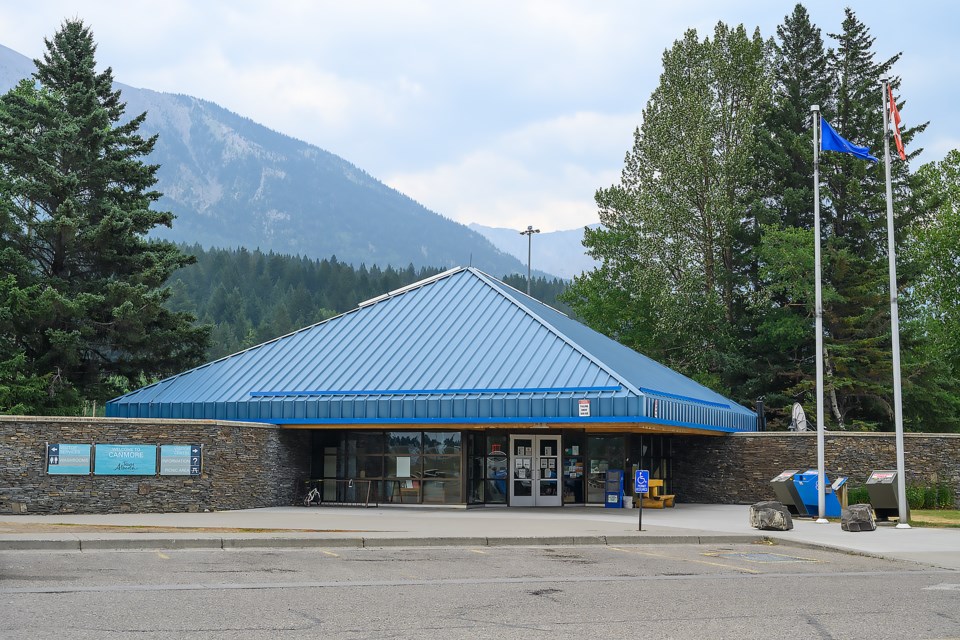CANMORE – The last Travel Alberta-funded visitor information centre in the province is facing closure.
An expiring contract between Tourism Canmore Kananaskis (TCK) and the province’s destination management agency, which ends Oct. 31, is calling the future of the Canmore Visitor Information Centre into question.
“We are hopeful that the continued use of the washroom buildings and the parking lots will still be allowed until further notice, but the visitor services building will be closed by then,” said TCK’s CEO Rachel Ludwig.
The tourism agency for Canmore and Kananaskis has been operating the visitor centre under two-year contracts with the province for more than a decade. That contract pays TCK to operate the facility, including staffing visitor services personnel and pay back for the lease.
It is the last visitor centre funded by Travel Alberta, which has been closing like facilities across the province largely due to a trending decline in visitors seeking destination information from brochures and maps.
The Canmore facility, located off the Trans-Canada Highway, had 120,000 visitors to its main building last year, representing roughly three per cent of all visitors to the region.
“The last number I found to compare that with was 2016 when there were actually 180,000 visitors that came through those doors,” said Ludwig.
Interaction rates with visitor centre personnel are even lower – from 24,000 per year in 2016 to 5,300 in 2023.
“That probably has directly to do with the rise of social media and the internet where visitors are getting the bulk of their information now,” said Ludwig.
“If you look online, you actually can see that many in our community act already as ambassadors to provide information to visitors on Facebook groups or TripAdvisor, and that will probably even increase with the rise of AI, which will be another digital tool for travelers to plan their vacation.”
Once TCK’s contract ends, the property will transfer over to Alberta Infrastructure. The closure notification is already being processed and the facility will be assessed for future use.
“This includes looking at facilities on the site such as the public washroom, trail access, and parking lot,” said Alberta Infrastructure’s director of communications Brendan Procé, in an email.
An RV sani-dump also located at the site has not been operational since the start of this year’s camping season.
Ludwig said this had nothing to do with the closure of the visitor centre and more to do with operational issues.
“RVs would line up and then people couldn’t access the parking lot anymore. Depending on what will happen with this site, the sewage dump could get open again.”
TCK has looked into the feasibility of taking over the property and estimates it would cost roughly $500,000 annually to operate the entire site.
At this time, Ludwig said that is not sustainable with TCK’s funding model, but the agency sees much value in retaining the site for visitor experiences.
While visitation to the information centre is down, washroom use is increasing. The washroom building had 260,000 visitors in 2016 and 330,000 in 2023.
Vehicle parking, too, especially from Legacy Trail users, accounts for about 100,000 bikes going back and forth on the paved trail between Canmore and Banff every year.
“It’s part of the visitor experience – like it or not. It’s not sexy, but parking and washrooms are part of the experience,” said Ludwig.
“On top of that, it provides value for tour operators. They go there as a meeting point to pick up guests, so guests can park there. It provides parking for tour buses. We only have the one designated spot for that in downtown Canmore right now and considering that group travel and buses is fairly sustainable, we will need some kind of option for tour operators there.”
Indigenous Tourism Alberta has previously looked at the site as a potential Indigenous interpretive centre, however, funding for a feasibility study on that was not approved.
Once TCK’s contract ends and the visitor centre closes, the site will be offered internally to see if there is a need for it to be utilized by government ministries.
If there is no need, it will be offered to the Town of Canmore for a fair market value.
Failing the Town making an offer, the property will go to private bidding. Ludwig said she hopes it does not come to that and TCK hopes to further discuss budgetary options at its August board meeting, which could include offering visitor services at the site seasonally.
Procé said Alberta Infrastructure will continue to work with ministry partners and the Town of Canmore to determine next steps.
The Local Journalism Initiative is funded by the Government of Canada. The position covers Îyârhe (Stoney) Nakoda First Nation and Kananaskis Country.




